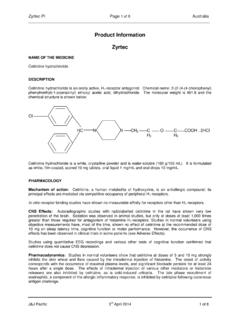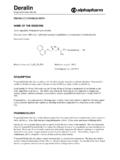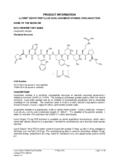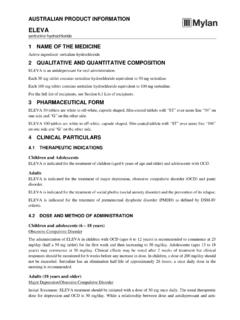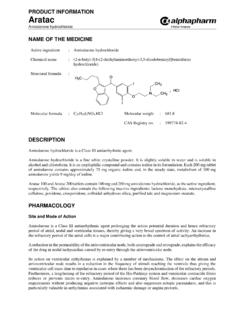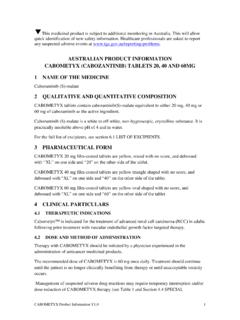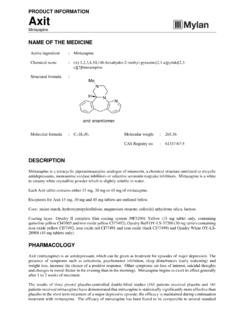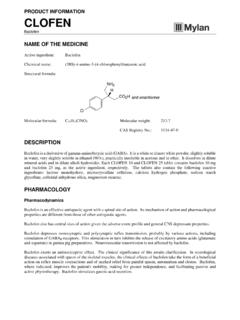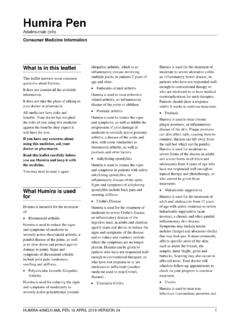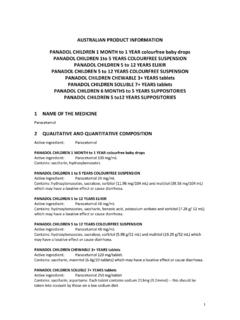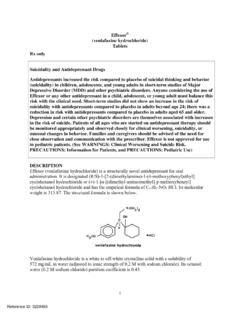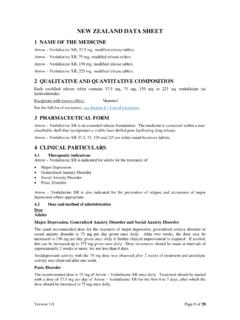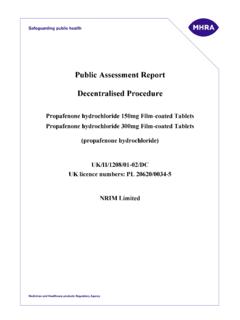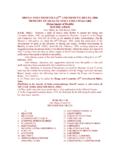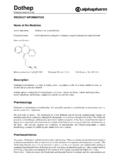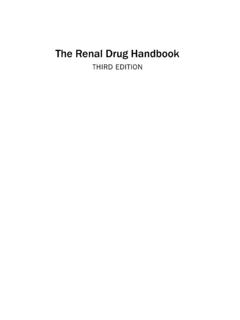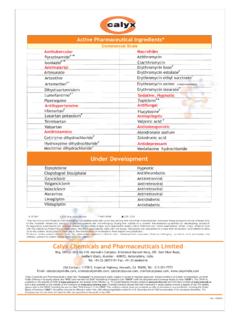Transcription of PRODUCT INFORMATION ENLAFAX-XR
1 AUSTRALIAN PRODUCT INFORMATION ENLAFAX-XR venlafaxine hydrochloride modified release capsules 1 NAME OF THE MEDICINE venlafaxine hydrochloride 2 QUALITATIVE AND QUANTITATIVE COMPOSITION Each 75 mg modified release capsule contains venlafaxine as the active ingredient. Each 150 mg modified release capsule contains venlafaxine as the active ingredient. ENLAFAX-XR also contains traces of galactose and sulfites. For the full list of excipients, see Section LIST OF EXCIPIENTS. 3 PHARMACEUTICAL FORM ENLAFAX-XR modified release capsules are available for oral use as: ENLAFAX-XR 75mg : Presented as Flesh opaque-flesh opaque, No 0, capsules printed on cap with VEN and on the body with 75 containing two white, round, biconvex mg film coated tablets ENLAFAX-XR 150mg : Presented as Scarlet opaque-scarlet opaque, No 00, printed on cap with VEN and on the body with 150, containing three white, round, biconvex 50 mg film coated tablets.
2 Some strengths, pack sizes and/ or types may not be marketed. 4 CLINICAL PARTICULARS THERAPEUTIC INDICATIONS ENLAFAX-XR is indicated for the treatment of: Major Depression, including prevention of relapse and recurrence where appropriate Social Anxiety Disorder DOSE AND METHOD OF ADMINISTRATION Usual Dose The usual recommended dose for the treatment of major depression or social anxiety disorder is 75 mg per day given once daily. After two weeks, the dose may be increased to 150 mg per day given once daily if further clinical improvement is required. If needed, this can be increased up to 225 mg given once daily. Dose increments should be made at intervals of approximately 2 weeks or more, but not less than 4 days. The recommended dose is based on results of clinical trials in which ENLAFAX-XR was mostly given once daily in doses from 75 to 225 mg.
3 Antidepressant activity with the 75 mg dose was observed after 2 weeks of treatment and anxiolytic activity was observed after one week. It is recommended that ENLAFAX-XR be taken with food. Each capsule must be swallowed whole with fluid. ENLAFAX-XR should be administered once daily, at approximately the same time each day. DO NOT DIVIDE, CRUSH, CHEW OR DISSOLVE. ENLAFAX-XR capsules are to be swallowed whole and are not to be divided, chewed or crushed. Taking divided, chewed or crushed ENLAFAX-XR capsules, in theory, could lead to the rapid release and absorption of venlafaxine . ENLAFAX-XR PRODUCT INFORMATION 2 Dosage Adjustment in Patients with Renal or Hepatic Impairment Patients with renal and/or hepatic impairment should receive lower doses of ENLAFAX-XR . The total daily dose of venlafaxine should be reduced by 25% to 50% for patients with renal impairment with a glomerular filtration rate (GFR) of 10 to 70 mL/min.
4 Haemodialysis clearances of both venlafaxine and ODV in humans are low. The total daily dose of venlafaxine should be reduced by 50% in haemodialysis patients. Patients with mild to moderate hepatic impairment should also have their dosage reduced by 50%. Further reductions in dosage should be considered for patients with more severe degrees of hepatic impairment. Because of individual variability in clearance in these patients, individualisation of dosage may be desirable. Dosage Adjustment in Elderly Patients No adjustment in the usual dose is recommended for elderly patients solely because of their age. As with any antidepressant, however, caution should be exercised in treating the elderly. When individualising the dosage, extra care should be taken when increasing the dose. Maintenance/Continuation/Extended Treatment The physician should periodically re-evaluate the usefulness of long-term ENLAFAX-XR treatment for the individual patient.
5 It is generally agreed that acute episodes of major depression require several months or longer of sustained pharmacological therapy. Whether the dose of antidepressant needed to induce remission is identical to the dose needed to maintain and/or sustain euthymia is unknown. Usually, the dosage for prevention of relapse or for prevention of recurrence of a new episode is similar to that used during initial treatment. Patients should be regularly re-assessed in order to evaluate the benefit of long-term therapy. In Social Anxiety Disorder, continuing therapeutic benefit has been established for periods of up to 6 months. The need for continuing medication in patients with Social Anxiety Disorder who improve with ENLAFAX-XR treatment should be periodically assessed. Discontinuing ENLAFAX-XR When ENLAFAX-XR at a dose of 75 mg/day or greater has been administered for more than 1 week is stopped, it is recommended that the dose be tapered gradually to minimise the risk of discontinuation symptoms.
6 In clinical trials with modified release venlafaxine capsules, tapering was achieved by reducing the daily dose by 75 mg at 1 week intervals. To facilitate tapering below 75 mg of ENLAFAX-XR , physicians may consider prescribing the mg of venlafaxine modified release capsules once daily ( ENLAFAX-XR mg capsules are not available). The time period required for tapering and the amount of dose reduction may depend on the dose, duration of therapy, and the individual patient. Patients should be advised to consult their physician before abruptly discontinuing ENALFAX-XR. In some patients, discontinuation may need to occur very gradually over periods of months or longer. CONTRAINDICATIONS Hypersensitivity to venlafaxine or any excipients in the formulation. Monoamine Oxidase Inhibitors (MAOIs) Concomitant use of venlafaxine and any monoamine oxidase inhibitors (MAOIs) or reversible MAOIs (RIMA) ( moclobemide, linezolid and intravenous methylene blue) is contraindicated.
7 Modified release venlafaxine capsules must not be initiated for at least 14 days after discontinuation of treatment with a MAOI. Similarly, modified release venlafaxine capsules must be discontinued for at least 7 days before starting treatment with any MAOI. Cases of serious reactions, such as potentially life-threatening serotonin syndrome (characterised by neuromuscular excitation, altered mental status and autonomic dysfunction) have been reported in patients receiving an SNRI in combination with MAOIs and RIMA and in patients who have recently discontinued an SNRI and have been started on a MAOI (See Section SPECIAL WARNINGS AND PRECAUTIONS FOR USE and Section INTERACTIONS WITH OTHER MEDICINES AND OTHER FORMS OF INTERACTIONS). SPECIAL WARNINGS AND PRECAUTIONS FOR USE ENLAFAX-XR PRODUCT INFORMATION 3 Clinical Worsening and Suicide Risk Patients with major depression, both adult and paediatric, may experience worsening of their depression and/or the emergence of suicidal ideation and behaviours (suicidality) or unusual changes in behaviour, whether or not they are taking antidepressant medications, and this risk may persist until significant remission occurs.
8 Suicide is a known risk of depression and certain other psychiatric disorders, and these disorders themselves are the strongest predictors of suicide. Antidepressants may have a role in inducing worsening of depression and the emergence of suicidality in certain patients during the early phases of treatment. As improvement may not occur during the first few weeks or more of treatment, patients should be closely monitored appropriately and observed closely for clinical worsening and suicidality, especially at the beginning of a course of treatment or at the time of dose changes, either increases or decreases. Pooled analyses of short-term placebo-controlled trials of antidepressant medicines (SSRIs and others) showed that these medicines increase the risk of suicidality in children, adolescents, and young adults (ages 18-24 years) with major depression and other psychiatric disorders.
9 Short-term studies did not show an increase in the risk of suicidality with antidepressants compared to placebo in adults beyond the age of 24 years; there was a reduction in the risk of suicidality with antidepressants compared to placebo in adults aged 65 years and older. The pooled analysis of placebo-controlled trials in children and adolescents with major depression, obsessive compulsive disorder, or other psychiatric disorders included a total of 24 short-term trials of nine antidepressant medicines in over 4400 patients. The pooled analyses of placebo-controlled trials in adults with major depression or other psychiatric disorders included a total of 295 short-term trials (median duration 2 months) of 11 antidepressant medicines in over 77,000 patients. There was considerable variation in risk of suicidality among medicines, but a tendency toward an increase in the younger patients for almost all medicines studied.
10 There were differences in absolute risk of suicidality across the different indications, with the highest incidence with major depression. No suicides occurred in any of the paediatric trials. There were suicides in the adult trials, but the number was not sufficient to reach any conclusion about the medicine effect on suicide. It is unknown whether the suicidality risk extends to longer-term use, beyond several months. However, there is substantial evidence from placebo-controlled maintenance trials in adults with depression that the use of antidepressants can delay the recurrence of depression. Consideration should be given to changing the therapeutic regimen, including possibly discontinuing the medication, in patients whose depression is persistently worse or whose emergent suicidality is severe, abrupt in onset, or was not part of the patient s presenting symptoms (see Section SPECIAL WARNINGS AND PRECAUTIONS FOR USE - Abrupt Discontinuation of ENLAFAX-XR ).
